My work for this class will be posted here.
Week 2 – 02/08 & 02/10 –
Read & Respond – Read pages 1-8 Jacques Ranciere’s The Ignorant Schoolmaster and respond
The message that the author was trying to portray to the reader was that teachers that only TEACH aren’t that effective in expanding their knowledge base. It is more beneficial when teachers open themselves to suggestions from their students because they can learn too. Nobody is perfect and teachers can be wrong as well, so a teacher that doesn’t open themselves to suggests becomes ignorant. Some teachers are dismissive or are not open to the possibility that they may be wrong. However, It’s better to view the class room as an exchange or pool of information. Where the teacher can teach but students can also share information that may be more accurate or even better. Through this process everyone gains more knowledge and everyone can grow.
Week 3 – 02/17 – Terrain Building & Level Design in Unity: Ground
Create a Unity scene with a full terrain (ground textures, grass, trees, wind,
player controller, post-process effects.
Explain what you’ve tried to achieve (what look/atmosphere, any references you may have used, etc.), and post a link to your video trailer.
I was going for realistic earthy, charred, volcanic terrain. Picture Rodan’s Lair from Godzilla. Hence the reason I added the charred rocks, lava pools, smoke and used the charred rock texture everywhere. I struggled with this whole assignment because I have never used Unity before. I watched the in-class recording several times in order to grasp the material and apply it in my own way. It took many hours but it was the only reference that I needed to complete the assignment because it was very detailed.
There were some more things that I tried to add that either didn’t work when I pressed play for some reason or were unavailable. I tried to add dead trees but there were no free ones available in the asset store. I also tried to to add some other effects such as the dust storm but the effect wasn’t showing up for some reason. I tried to add a tree stump but kept getting errors about it conflicting with the lighting or shading.
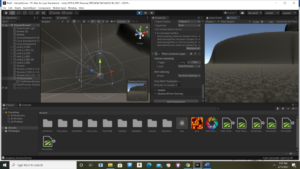 Smoke rising effect 2 of 2
Smoke rising effect 2 of 2 Charred rock 1 of 6
Charred rock 1 of 6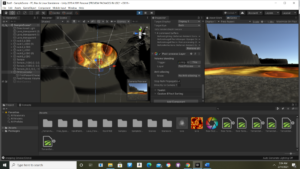 Lava pool 1 of 3
Lava pool 1 of 3
Video preview
https://www.youtube.com/watch?v=WNMv70wt7fU
Week 4 – 02/22 & 02/24
Watch & Respond – Watch Cybernetics & System thinking with Paul Pangaro
A system is an organized framework that works together to produce some type of desired result.
Cybernetics involves, communicating, problem solving or understanding things in terms of systems, as opposed to individual subjects. It involves acting, sensing and comparing current data to the desired end result. This process may occur multiple times until the desired end result is achieved or another end goal is reached. The desired outcome is subject to change and this means the system that is being used is subject to change as well. Feedback is very important in terms of cybernetics because feedback is required in order to made positive changes within a system. Without feedback (good or bad)
it would be harder to become aware of errors within a system and thus make it harder to improve the system to achieve its end goal. An example of cybernetics that the men in the video used was scheduling a meeting. The end goal of course being them successfully scheduling the meeting. The system being them communicating and trying to find a place they’d both like to meet up and eat. This process of them bargaining and suggesting places to meet is cybernetics. The process of them settling to meet and talk over tea instead of food is another component of cybernetics that I mentioned before. The component where I mentioned that the end goal is subject to change as desires change. As desires change, systems change.
This is cybernetics.
Week 4 – 02/22 & 02/24 – C# Scripting Part 1 & Guidelines for Project 1:KontrolLecture/Lab – [What is a system?], Mapping exercise, C# scripting (conditional logic, input methods, generate and random)
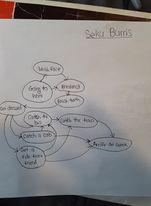
*Week 5 – 03/01 & 03/03 – *Read & Respond (Monday)* Read Katherine N. Hayles’s Informational Infection and Hygiene in SnowCrash (pages 287 to 297)
This reading was very detailed. It spoke in great detail about a book called snowcrash where a computer virus existed that was capable of infecting people and machines. The virus was able to infect people that were able to understand code and would infect them as they were analyzing code. The whole idea behind the this concept was this idea that the brain of a human and the way in which computers work is very similar. The networking of neurons and synapses within our brains is in a way representative of the way a computer network works. By comparing these two things the author was putting forth the idea that humans are not very different from machines. Contrary to popular belief. I agree with this because, in many ways computers are based off of humans and we operate. They communicate using a language just like humans. They do them same tasks that we do such as categorization and organization but more accurately.
Week 5 – 03/01 & 03/03 – C# Scripting Part 2 & Deliver Project 1: KontrolLecture/Lab – [What is a code?], C# scripting (access other scripts, find with tag, coroutine).
Lab – Project 1: Kontrol presentations.
This is my first unity project. I created a magma based volcano terrain with rocks, trees, grass and of course lava. It features an erupting volcano with lava pouring out the front of it. Behind the volcano is moss, grass, tress, a small canyon and rocks. This terrain also has texture scripts attached to some of the rocks within it. So when the player touches certain rocks their textures will change. Adding the texture changing scripts and collisions to the rocks was very challenging but thanks to the professor I was able to accomplish it. This terrain is a big improvement from my original attempt from week 3 because I added post processing effects, used different brushes, used a variety of different textures to make it more realistic, added trees, leveled the terrain correctly, changed the skybox, added fog and made good use of various particle effects. I’d say I’m generally more comfortable using Unity now compared to two weeks ago.
Understanding how to manipulate particle effects was a bit of a challenge for me but I eventually managed it. I even managed to create a custom particle effect that looks like fire. The skybox I found wasn’t what I really wanted but all of the other ones I wanted to use were too dark for the scenery. All in all I accomplished everything else I wanted to with this terrain. It was very difficult for me to improve this terrain and took many hours because I’m still not used to using Unity. Below I have pictures of my terrain and a short video showing how the texture script works during game play.

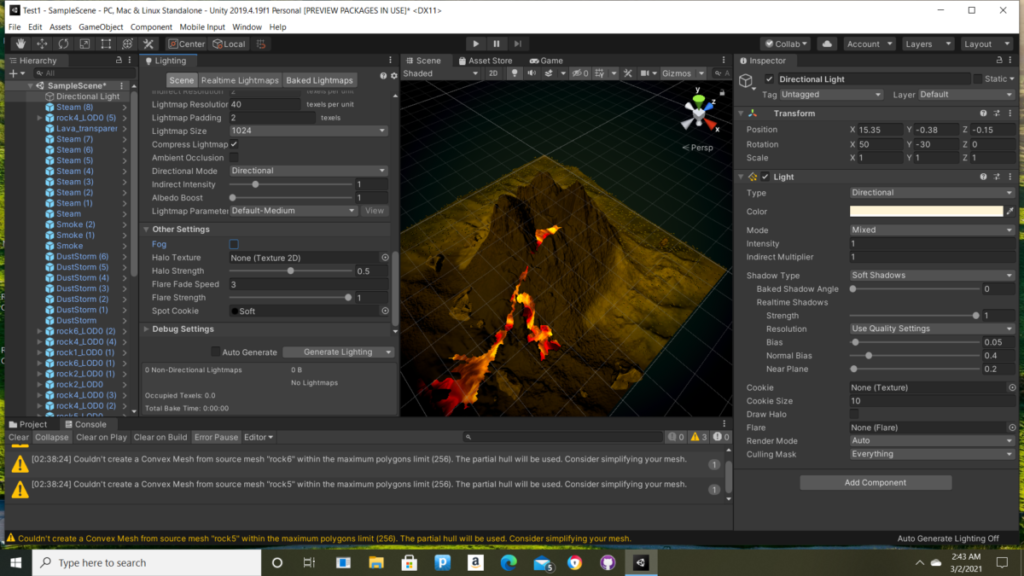
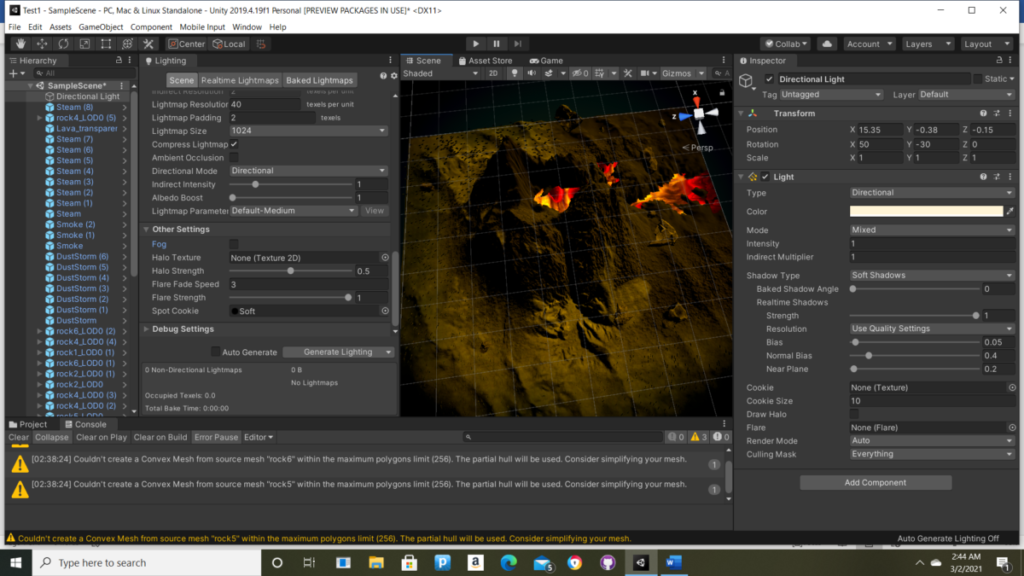
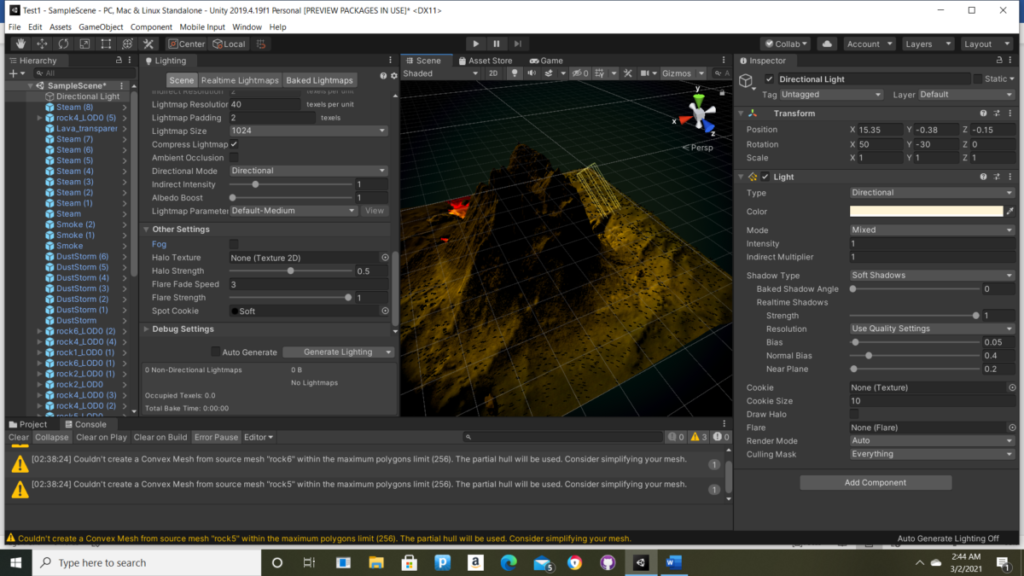

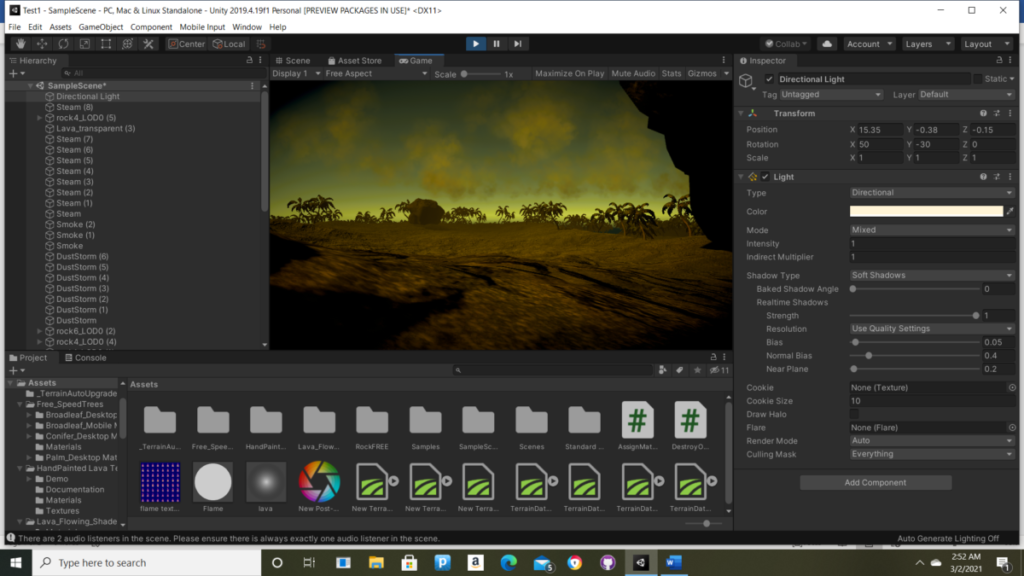
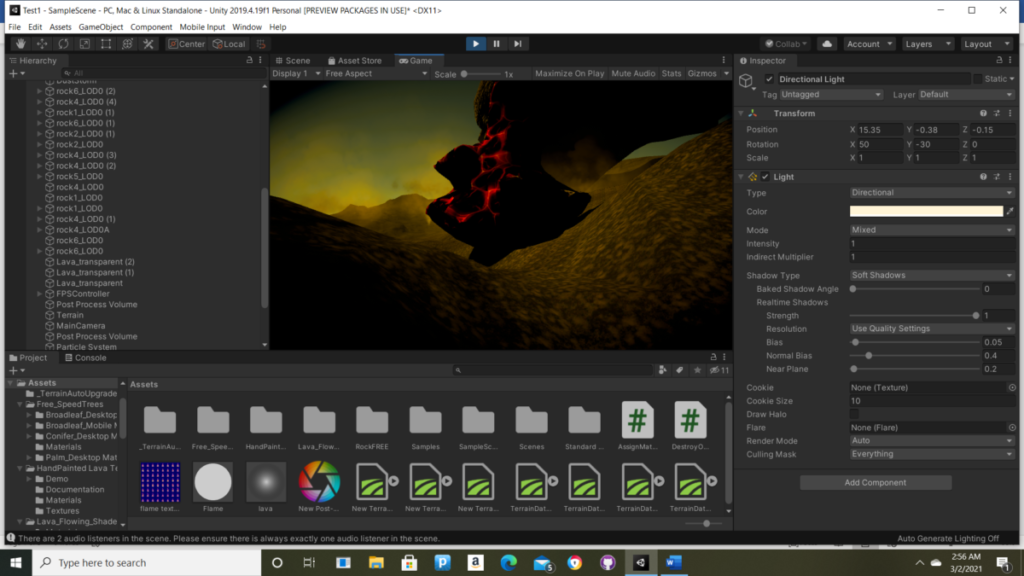
Week 6 – 03/08 & 03/10 – Introduction to XR Development (AR Foundation & Oculus SDK)Lecture/Lab – Current state of AR, Using AR Foundations to create an AR experience in Unity.
Lecture/Lab – Current state of VR, Using Oculus Integrations to create a VR experience in Unity
This week in unity we’re learning about how to integrate VR technology into our mobile devices. By doing this we can cause an effect to happen on a technological device based on something that it picks up in the real world such as sounds or images. Here I was attempting to use a picture of a “saradomin sword” (from a game I play) to cause a black square to appear when it is picked up by my phone. Unfortunately my Unity application was having problems finding the JDK file and this stopped the application from completing the build. I am in the process of trouble shooting this issue and will come back to this in the future when I can fix this problem. However, I still understood the concept and Lab so I am pleased.


Week 7 – 03/15 & 03/17 – Guidelines & Lab time for Project 2: Intervene.
Read & Respond – Read Donna Haraway’s A Cyborg Manifesto and respond, p1-8 (pdf link here)
This reading was pretty complicated due to the vocabulary and wording. However, what I understood from the reading was that the author wanted the reader to understand HER concept of what a cyborg was, as opposed to the general understanding of the word.
Today most people would describe a cyborg as a person that is half human and half machine but the author defines it very differently. She defines it as “a rejection of rigid boundaries, notably those separating human from animal and human from machine.” With this more complex definition she relates the term cyborg to politics, technology and feminism. She encourages feminists to move past the societal boundaries imposed upon them in relation to gender, politics and feminism itself. More specifically she points out the flaws within radical feminism by bringing up 1 sided argument proposed by feminists.
She also mentions that humans can be considered to be cyborgs as well, based on how they utilize technology. The idea that a cyborg has to have the technology embedded within itself is something she rejects. She implies that just the connection we have with technology is enough to have the label. Things such as how we interact with our phones, computers, filing machines, construction machines, headphones etc is enough to make us cyborgs by her standards. In a sense shes right though, because we use technology to complete many tasks just as a cyborg would. The only difference is that we are not physically connect to the technology itself. However, we still use technology to accomplish many tasks, just as a cyborg would.
Week 7 – 03/15 & 03/17 – Guidelines & Lab time for Project 2
Do (before class): Based on the tech demos given in class last week, create a simple AR (image detection) or VR build using Unity. Post a mini tutorial on your portfolio for your future self.
VR Unity Tutorial
This tutorial will go over how to set up the VR headset using Unity.
Open Unity
Create a new project in Unity project
Go to file – project settings
(Player tab opens)
Go to “XR Plugin manager” on the list, inside the player tab and Install the “XR plugin manager”.
Click on the XR manager Again and a tab will open now.
Click the second box from the top labeled “Oculus” to install it.
Create a new camera and convert it to an XR camera(XR rig) by right clicking the camera in the hierarchy window and scrolling down to the XR option on the menu. CLICK it.
Change the camera tag as well
And this will connect the VR headset to Unity when you press play so that the camera tracks the headset in relation to the sensor.
Go to the asset store and download the free oculus integration package by oculus.
This will allow you to have access to controls and be able to perform basic interactions using VR such as grabbing objects, throwing objects distance grabbing objects etc.
After downloading this Unity will close and restart.
You will have an Oculus in the Project window now.
There are some example scenes that come with the download that you can experiment with.
They provide examples of prebuilt environments where the user can use their hands (Represented as different objects) and the controls to interact with the environment.
And there is your VR tutorial
Week 8 – 03/22 & 03/24 – Watch Introduction to affect theory: Brian Massumi & Eve Sedgwick; respond.
Affect theory is a very broad subject that spreads across the fields of psychology, neuroscience, interpersonal communications and gender studies according to the video. Affect theory suggests that actions and the materials around us can have various effects on us and the people around us that we aren’t necessarily aware of in the moments that they happen.
With the definition of affects being measurable forces or intensities, unconsciously or involuntary reactions or feelings and perceived internal feelings. As mentioned by the video, affects are also subjective and prior to intentions.
An example of affect theory that was mentioned in the video would be what happens someone speaks. The sound waves bounce off of someone’s eardrum and thats the physical affect of their language. As mentioned before, this subject spreads across various fields so looking at it from psychological or emotional perspective, one would analyze what exactly was said and how it affected a person or persons emotions as opposed to analyzing the physical affect.
Another aspect of affect theory is not only the way in which things affect one another but also the POTENTIAL for one thing to affect another and the POTENTIAL outcomes that go along with that.
Week 10 – 04/12 & 04/14 – Project 2: Intervene:
Watch – Watch The Weirdness of being, by Erik Davis and respond
The video touched on a lot of concepts but the main focus was how and why, we as people deem something as weird. The speaker states that one reason in which we label something as weird is weather or not it goes against social norms. This was an interesting point to make because he links this back to several sociological concepts subjects that we consider or once considered to be weird at one point. Such as homosexuality. It was generally considered and accepted as weird because it was not accepted as a social norm. So homosexuals were seen as weird. Another group of people he brings up is gothic people because they tend to express their beliefs and sense of self in ways that most people don’t. For example they dress in ways and apply make up in ways that typically go against social norms. Another way he mentions that we use to determine something is weird is weather or not it is peculiar, disturbing, odd or unknown. That space or moment when cross over from the known to the unknown is usually when we enter the WEIRD…
Week 10 – 04/12 & 04/14 – Project 2: Intervene: Proof of Concept Presentations, Audio Visualizer
Stephany Pena and I worked on recreating the underwater theme based room of the Museum of Natural History. She imported all of the model assets and I recreated the room itself. We struggled getting the AR to work because we weren’t able to get FORK to work properly when pushing the final changes. So there was an issue getting the files onto Stephany’s computer. However, we did as much as we could and still managed to make a room that looked like the actual room from the museum. Using the fish models that Stephany gathered I was able to place fish models behind the glass like they are in the actual museum. Building the museum took a few hours but wasn’t really difficult. There was a lot of duplication of walls and floors so I didn’t have to rebuild the same objects multiple times. The textures weren’t as accurate as I thought they’d be but they still mimic the actual room pretty well.
Here’s the link to view the original room from the museum that we recreated.


Week 11 – 04/19 & 04/21 – Communication & Networking & Guidelines Project 3: Connect!Lecture/Lab – Guidelines Project 3: Connect! & Lab time.
Lab – Creating a live video chat app using the Agora SDK & Lab time.
Do (before class) – Use the Reaktion plugin by Keijiro and create a particle system that reacts to a music you’ve imported in your project
Today’s challenge: Complete the tutorial linked below before the end of the class!
Successfully created the video chatting application within unity. However, I was met with the “cannot find JDK error” when trying to transfer the app to my android phone. I’m still unable to find the solution to this error after hours of trying various resolution methods.




Week 13 – PROJECT 3:
Using the 2 tutorials above I was able to create a mini 2D game level. With the first tutorial I created a small 2D level and with the second tutorial I created a small 2D player that is capable of basic movement (move left/right and jumping). Understanding how to create the level was actually more difficult that implementing the character. Mainly do to the fact that there were several components I had to utilize and understand to create the level properly. Whereas with the player icon I just had to create a small script and test it out to make sure it worked.
Below is a picture of my game level with the character on the bottom right. The player must jump on the platforms and make their way across the stage to win.





You’re awesome!